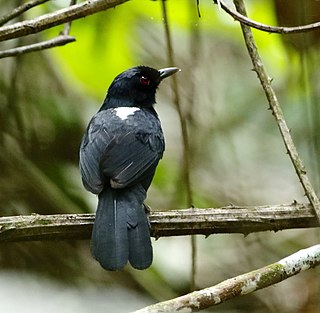
The white-bellied antbird, is a passerine bird in subfamily Thamnophilinae of family Thamnophilidae, the "typical antbirds". It is found in Panama, on Trinidad, and across northern South America. It is also called Swainson's antcatcher after William John Swainson, who first described it scientifically.

The blackish antbird is a species of passerine bird in subfamily Thamnophilinae of family Thamnophilidae, the "typical antbirds". It is found in Bolivia, Brazil, Colombia, Ecuador, French Guiana, Guyana, Peru, and Suriname.

The Roraiman antwren is an insectivorous bird in subfamily Thamnophilinae of family Thamnophilidae, the "typical antbirds". It is found in Brazil, Guyana, and Venezuela.

The warbling antbird is a complex consisting of six species of antbirds that until recently were considered a single species found throughout the Amazon in South America. Based on vocal differences and to a lesser degree differences in plumages, it has been recommended treating them as separate species:

Hypocnemis is a genus of passerine birds in the family Thamnophilidae. They are resident breeders in tropical Central and South America.

The yellow-browed antbird, or yellow-browed antwarbler, is a species of bird in subfamily Thamnophilinae of family Thamnophilidae, the "typical antbirds". It is found in Brazil, Colombia, Ecuador, and Peru.

The scalloped antbird is an Endangered species of passerine bird in subfamily Thamnophilinae of family Thamnophilidae, the "typical antbirds". It is endemic to Brazil.

The black-faced antbird is a species of bird in subfamily Thamnophilinae of family Thamnophilidae, the "typical antbirds". It is found in Bolivia, Brazil, Colombia, Ecuador, Peru, and Venezuela.

The moustached antwren is a species of small Neotropical bird in subfamily Thamnophilinae of family Thamnophilidae, the "typical antbirds". It is found in Brazil, Colombia, Ecuador, Panama, and Peru.

The East Amazonian fire-eye is an insectivorous bird in subfamily Thamnophilinae of family Thamnophilidae, the "typical antbirds". It is endemic to Brazil.

The streak-backed antshrike is a species of bird in subfamily Thamnophilinae of family Thamnophilidae, the "typical antbirds". It is found in Brazil, Guyana, and Venezuela.

The lined antshrike is a species of bird in subfamily Thamnophilinae of family Thamnophilidae, the "typical antbirds". It is found in Colombia, Ecuador, and Peru.

The Guianan warbling antbird, or Guianan antwarbler, is an insectivorous bird in subfamily Thamnophilinae of family Thamnophilidae, the "typical antbirds". It is found in Brazil, French Guiana, Guyana, Suriname, and Venezuela.

The Imeri warbling antbird or Imeri antwarbler, is a species of bird in subfamily Thamnophilinae of family Thamnophilidae, the "typical antbirds". It is found in Brazil, Colombia, and Venezuela.

The Peruvian warbling antbird or Peruvian antwarbler, is a species of bird in subfamily Thamnophilinae of family Thamnophilidae, the "typical antbirds". It is found in Bolivia, Brazil, Colombia, Ecuador, and Peru.

The yellow-breasted warbling antbird or yellow-breasted antwarbler, is a species of bird in subfamily Thamnophilinae of family Thamnophilidae, the "typical antbirds". It is found in Bolivia, Brazil, and Peru.

The Rondonia warbling antbird or Rondonia antwarbler, is a Vulnerable species of bird in subfamily Thamnophilinae of family Thamnophilidae, the "typical antbirds". It is found in Bolivia and Brazil.

The rufous-faced antbird is a species of bird in subfamily Thamnophilinae of family Thamnophilidae, the "typical antbirds". It is endemic to Brazil.

The Roraiman antbird is a species of passerine bird in subfamily Thamnophilinae of family Thamnophilidae, the "typical antbirds". It is found in Brazil, Guyana, and Venezuela.

The Manicore warbling antbird or Manicore antwarbler, is a species of insectivorous bird in subfamily Thamnophilinae of family Thamnophilidae, the "typical antbirds". It is endemic to Brazil.






















